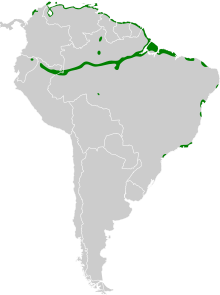Bicolored conebill
| Bicolored conebill | |
|---|---|

| |
| Scientific classification | |
| Kingdom: | Animalia |
| Phylum: | Chordata |
| Class: | Aves |
| Order: | Passeriformes |
| Family: | Thraupidae |
| Genus: | Conirostrum |
| Species: | C. bicolor
|
| Binomial name | |
| Conirostrum bicolor (Vieillot, 1809)
| |

| |
The bicolored conebill (Conirostrum bicolor) is a small passerine bird. This member of the tanager family is a resident breeder in South America from Colombia, Venezuela and Trinidad south and east to the Guianas, northeast Peru and Brazil.
Habitat[]
Its habitat is coastal mangrove swamps and neighbouring woodlands. The small feather-lined cup nest is built in a mangrove tree, and the normal clutch is two brown-blotched buff eggs. Nests are often parasitised by shiny cowbirds.
Description[]
The bicolored conebill is 11.4 cm long and weighs 11 g. The adult is grey-blue above and buff-tinged grey below, with red eyes, pink legs and a sharp, pointed bill. The primary flight feathers are bluish with brown edgings. The sexes are similar, although the female may be a little duller, but immature birds are greenish above and have pale yellow underparts. Birds sometimes breed in immature plumage.
Diet[]
These warbler-like birds eat mainly insects and occasionally seeds. The bicolored conebill's call is a thin tseep.
References[]
- ^ BirdLife International (2018). "Conirostrum bicolor". IUCN Red List of Threatened Species. 2018: e.T22722089A132011675. doi:10.2305/IUCN.UK.2018-2.RLTS.T22722089A132011675.en. Retrieved 11 November 2021.
- ffrench, Richard (1991). A Guide to the Birds of Trinidad and Tobago (2nd ed.). Comstock Publishing. ISBN 0-8014-9792-2.
- Hilty, Steven L (2003). Birds of Venezuela. London: Christopher Helm. ISBN 0-7136-6418-5.
- IUCN Red List near threatened species
- Conirostrum
- Birds of Venezuela
- Birds of the Guianas
- Birds of Trinidad and Tobago
- Birds of the Amazon Basin
- Birds of Brazil
- Birds of the Atlantic Forest
- Birds described in 1809
